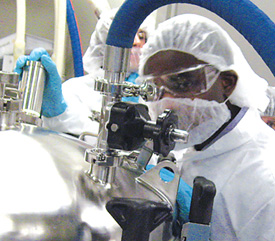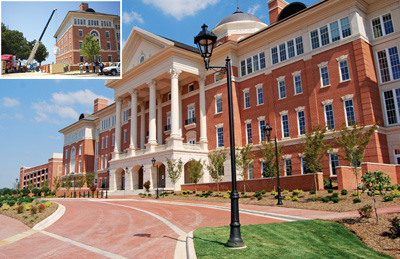cientists, scientists and more scientists. Or, simply put, you need lots of smart people in your community to be successful in attracting biotech research and development facilities.

Companies engaged in biotech R&D – facilities that explore the science of modifying human health, food supplies or the environment – face a multitude of factors which drive their location and operations. These include specialized real estate and space options where experiments and trials can be conducted, as well as the availability of researchers, technicians, and “quality of place” needed to attract and retain the best and brightest to a location. This contrasts with bio-manufacturing facilities, which are more focused on operating costs as a critical component of site selection and location retention.
Based on our company’s experience as site location consultants and in conversations with other companies and consultants throughout the globe, we see a constant, reoccurring set of criteria that drives the location process for biotech R&D facilities. They include:
• Human capital – a skilled labor pool.
• A clustering of other biotech R&D facilities.
• The protection of intellectual property rights, which is why some countries are better equipped to attract R&D facilities than others.
• Quality of place. Does the community offer a quality of life/place that will attract and retain talent?
• Access to venture capital. Given the long time horizon of biotech research, the availability or access to venture capital can help tip the scales. In many instances access or potential access to such an infusion of dollars will be key in determining where to locate an R&D venture.
• The federal regulatory environment. It is more difficult to gain approvals through the U.S. regulatory process than it is in some foreign countries that have the legal infrastructure to support biotech R&D; conversely, other markets are less friendly to such R&D.
• Overall business costs, e.g. labor, utilities, taxes.
• A culture of innovation and presence of academia. Many times, academia and the private sector will partner on R&D efforts to create training streams or complementary institutes. Additionally the presence of a strong research base or expertise in disciplines that feed the research stream is also helpful.
Of the criteria noted above, the four most important are the availability of human capital – specifically, an intelligent work force; the clustering of other R&D facilities in the region; access to venture capital; and a spirit of innovation that is ingrained in the minds of the labor force in the region and community leaders who are helping to drive the region’s success.
While these variables are a “must” for R&D in other industries, they are especially important for biotech R&D companies because of the long time horizon of development, as well as the added complexity given the regulations that must be followed. Hence, the ability to locate a biotech R&D facility in a region or community will only happen to a select few.

In addition to the above “measurable” criteria, an important intangible is the leadership of a state’s and region’s public and private sectors. We are able to observe quickly how a state or a region will step up to the plate (or not) and show leadership in making a deal happen.
The Research Triangle Park of North Carolina (RTP) offers one case study on how a region assembled the above assets and worked to transform itself into a biotech center. Currently celebrating its 50th anniversary, the Park and the region surrounding it exemplify the spirit of innovation needed to build and support the biotech industry that has grown in the state.
While the region possessed many of the assets noted above, the state’s concerted and sustained effort to grow and nurture biotech industries has been key in establishing the region’s competitiveness. Coupled with the strengths of the region’s world-class research universities and the existing concentration of biotech companies in the RTP, the establishment of the North Carolina Biotechnology Center in 1984 has provided the institutional infrastructure for a range of grants and loans for young biotech companies and education training programs to show the importance of biotechnology.
These critical masses of biotech industries and activities have been key to solidifying the region’s competitive position as a location for biotech R&D facilities. As RTP President and CEO Rick Weddle notes, “It’s the region’s recognition that these changes are trans-generational in nature and its commitment to nurturing the entire ‘knowledge ecosystem’ that set the Research Triangle apart. Without the sustained and wide-spread support for the innovation infrastructure to support biotech R&D, the region would not be as well positioned as it is today.”
But the RTP is just one example. Years ago, other states and countries like California, Washington, India, Singapore and Ireland also recognized the need to take leadership roles and worked to create a physical and intellectual infrastructure. Their early success with sustained and sizeable investments has built upon itself and created a strong concentration of the types of companies and other knowledge assets that set them apart and work to attract other biotech efforts.
Nevertheless, new entrants to the market are trying to position themselves in the industry. Kannapolis, N.C., has developed a $500-million research campus called the North Carolina Research Campus with a “build it and they will come” mentality. With private investor and state government support, it may indeed work, since it meets most of the criteria for an R&D facility. Other locations like Huntsville, Ala., and the new Scripps Research Institute in Palm Beach County, Fla., demonstrate success through their vision. Huntsville’s achievements as an R&D location are the direct result of NASA’s Marshall Space Center and the Army’s Redstone Arsenal. These facilities served as a catalyst to drive the infrastructure in place culminating in the research cluster it is today.
Understanding that nearly all R&D location searches are global in nature and that the site selection process is really a “site elimination process” will give some communities pause when they grasp that the odds are not in their favor that a biotech R&D facility will locate in their community. With countries and locations around the globe equipped and externally proactive in the recruitment and retention of all forms of life sciences companies, the competition continues to grow. But those communities that stand out above the crowd in the global sea of competition are those that ultimately get noticed and win.
Jay Garner, CEcD, CCE, is president of Atlanta-based Garner Economics, LLC, which specializes in providing innovative solutions for economic development success in a highly competitive global market. Visit www.garnereconomics.com.